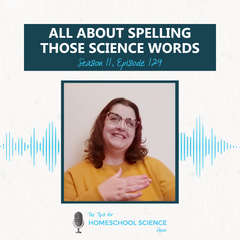FREE Shipping on all our products! (Please Note: Orders may experience a delay of a week or more in shipping due to the high volume of orders at this time of year.)
FREE Shipping on all our products! (Please Note: Orders may experience a delay of a week or more in shipping due to the high volume of orders at this time of year.)
How to get through your science fair project – Science Fair Session, part 2 {Episode 48}
May 21, 2018 2 min read

How to get through your science fair project – Science Fair Session, part 2 {Episode 48}
The scariest part of the science fair project is usually the experiment. How do you design one to test your hypothesis? What information do you need to record? And what the heck are all those variables?
Hi, I’m Paige Hudson and you are listening to the Tips for Homeschool Science Show where we are going to chat about the answers to those questions as we work on breaking down the lofty concepts of science into building blocks you can use in your homeschool!
Listen to this episode
Share the Tips
If you found these homeschool science tips to be helpful, would you please take a moment to rate it on iTunes or Stitcher? This would help me tremendously in getting the word out so that more earbuds are filled with science-teaching encouragement.
Highlights

The third step of the science fair project is to formulate a hypothesis. Your students need to:
- Review the research.
- Formulate the answer.
The fourth step of the science fair project is to design an experiment. Your students need to:
- Choose a test.
- Determine the variables.
- Plan the experiment.
- Review the hypothesis.
A quick look at variables:
- The independent variable is the factor that is controlled or changed by the scientist performing the experiment. (What factor are we trying to test?)
- The dependent variable is the factor being tested in the experiment. (What factor will we use to measure progress?)
- The controlled variable is a factor that is not being examined in the experiment. (What factor will remain constant?)
The fifth step of the science fair project is to perform the experiment. Your students need to:
- Get ready for the experiment.
- Run the experiment.
- Record any observations and results.
Observations are the record of the things the scientist sees happening in an experiment.
Results are the specific and measurable data that he records in the experiment.
Takeaway Tidbits
The hypothesis is an educated guess at the answer to the original question you asked for your science fair project. (Pin this Tidbit)
Having more than one sample in your experiments helps to make your results verifiable. (Pin this Tidbit)
A little bit of prep-work paves the way for a smooth experiment. (Pin this Tidbit)
Additional Resources
See the full conference session - Eliminate your fears and doubts surrounding a science fair project.
Check out the following articles for more tips to help with your science fair project:
- How to write a science fair project hypothesis
- All About Experiment Variables
- Observations vs. Results
Or get the full book - The Science Fair Project: A Step-by-Step Guide.
Also in {Podcast} The Tips for Homeschool Science Show
All About Spelling Those Science Words {Season 11, Episode 129}
March 25, 2024 7 min read

In this episode, we'll be interviewing Robin Williams from All About Spelling. Click "Read More" to listen is as we discuss tips and tricks for spelling all those science words!
How should you handle notebooking through the different ages? {Season 11, Episode 128}
March 18, 2024 3 min read

Writing in Science with a Well-Trained Mind (Interview) {Season 11, Episode 127}
March 11, 2024 16 min read

Click "Read More" to listen in as Susan Wise Bauer and Susanna Jarret join Paige to share tips and tools about the third key to teaching science!
Subscribe
Sign up to get the latest on sales, new releases and more …

